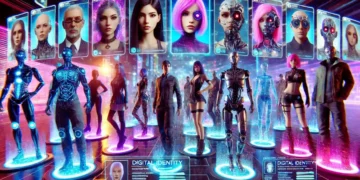In a recent interview, Coinbase’s CEO, Brian Armstrong, unfolded a visionary perspective at the emerging intersection of artificial intelligence (AI) and cryptocurrencies. Envisioning a future where autonomous AI “agents” conduct transactions using cryptocurrencies, Armstrong foresees a transformative shift in our interaction with the digital economy.
The Rise of Autonomous AI Agents in Digital Transactions
Armstrong paints a picture where AI robots, operating as autonomous agents, undertake various tasks in the digital realm. These agents, as he elucidates, will need to execute transactions to access services such as information and APIs. Highlighting the inadequacy of traditional payment systems like Visa for these transactions, Armstrong proposes that cryptocurrencies will be the natural choice for this new AI ecosystem.
Coinbase’s Integration of AI: Pioneering New Avenues for Cryptocurrencies
Beyond facilitating transactions, Armstrong suggests that the amalgamation of AI and cryptography can play a pivotal role in establishing the origin of information. In an era rife with fake news and deepfakes, encryption could authenticate digital content like videos, images, and articles, ensuring their authenticity and source credibility.
“In the world of misinformation generated by LLM or viral images and videos, even if not real, I believe encryption has a role to play there,” stated Armstrong.
Coinbase, being one of the world’s largest cryptocurrency exchanges, is already deploying artificial intelligence tools across various facets of its business operations. These encompass fraud prevention and customer support, with Armstrong primarily highlighting the use of Copilot, a tool aiding developers in code writing, saving valuable time.
Cryptocurrencies and AI: Verifying Information in the Age of Deepfakes
Looking ahead to the future of cryptocurrencies, Armstrong emphasizes the potential of emerging technologies such as stablecoins and second-layer solutions to make payments more viable. He envisions a promising future for cryptocurrencies in emerging markets like Africa and believes that decentralized social networks will also play a significant role. With decentralized identity such as ENS, individual posts on social platforms could evolve into NFTs, opening new possibilities for digital interaction.
Armstrong asserts that while stablecoins, DeFi, and NFTs already constitute a significant market, there is still a long way to go. Coinbase views these technologies as pivotal in driving the next wave of cryptocurrency adoption, alongside decentralized payments and social networks.
“There will be more AI agents in the future, essentially robots trying to perform various tasks in the world,” Armstrong said.
These agents, he notes, will need to conduct transactions to pay for services such as information and API calls. “It’s hard to imagine a world where different artificial intelligence agents pay each other with Visa or something like that,” Armstrong added, suggesting they will likely use “a native digital currency like cryptocurrencies.”
Armstrong also hinted that the “intersection between AI and cryptocurrencies” could lead to other use cases, such as establishing the origin of information.
“In the world of misinformation generated by LLM or images or videos of people that can go viral even if not real, I think cryptocurrencies have a role to play there,” said Armstrong. He suggested that videos, images, and articles could be cryptographically signed in the ENS identifiers of publishers, verifying they come from an authentic source, like a recognized author or news organization.
Coinbase’s Current AI Implementation and Future Prospects
Coinbase is already employing artificial intelligence tools, Armstrong mentioned, in areas like fraud prevention, customer support, and other backend services. “We use things like Copilot, which helps our developers write code,” he said, adding that Coinbase engineers report it saves them an average of an hour per day.
AI, he said, has a variety of potential uses including “user interface design and even some forecasting; From a financial standpoint, FP&A functions could integrate this.”
The Future Landscape of Cryptocurrencies
Armstrong also highlighted some areas of cryptocurrencies that Coinbase expects to bear fruit in the coming year, including payments. “We’ve seen a couple of enabling technologies come together (stablecoins, layer 2 solutions like Base) that I think will make payments increasingly viable,” he said, noting “sparks” of activity in emerging markets such as Africa.
Decentralized social networks are also “exciting,” Armstrong said. “Now that we have a decentralized identity, with ENS, we can start building a follower graph,” he said. “You can begin to make every post someone makes, whether it’s text, images, or video, essentially an NFT.”
Several decentralized social network projects were launched last year amid the well-publicized struggles of the legacy Twitter platform, including Bluesky, Nostr, Friend.tech, and Lens Protocol.
Stablecoins, DeFi, and NFTs have “a long way to go,” but can “help propel cryptocurrencies into the next wave of adoption,” along with decentralized payments and social networks, said Armstrong. “Each of them already has tens of billions of dollars locked up, so they’re not new. But you know, how do we get 100 million or a billion people to use it every day?”
ChatGPT Access for Less: Unlocking the Power of AI on a Budget
Conclusion
In conclusion, Armstrong’s insights reflect an ambitious vision for the future of AI and cryptocurrencies, envisioning a synergy that could reshape digital and financial interactions. As these technologies evolve, they are poised to offer innovative solutions to current and future challenges in the digital realm.
Follow us on our social networks and keep up to date with everything that happens in the Metaverse!
Twitter Linkedin Facebook Telegram Instagram Google News Amazon Store












































